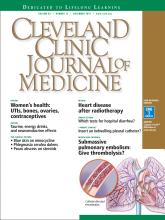Article Figures & Data
Tables
- TABLE 1
American Heart Association definition of right ventricular dysfunction and myocardial necrosis
Risk stratification test Recommended criteria B-type natriuretic peptide (BNP) > 90 pg/mL N-terminal-pro-BNP > 500 pg/mL Troponin I > 0.4 ng/mL Troponin T > 0.1 ng/mL Transthoracic echocardiography Ratio of right ventricular diameter to left ventricular diameter > 0.9 (apical four-chamber view)
Qualitative right ventricular systolic dysfunctionComputed tomographic pulmonary angiography Ratio of right ventricular diameter to left ventricular diameter > 0.9 (reconstructed four-chamber view) Electrocardiography New complete or incomplete right bundle branch block Anteroseptal ST-segment elevation or depression Anteroseptal T-wave inversion Information from Reference 3.
Agent Loading dose Maintenance dose Fibrin specificity Alteplasea,b 10 mg over 10 minutes 90 mg over 2 hours Moderate Desmoteplasec 125–250 μg/kg over 1–2 minutes None High Reteplasea 10-unit bolus 10-unit bolus given 30 minutes after initial dose Low Streptokinase3 250,000 units over 30 minutes 100,000 units/hour over 12–24 hours None Tenecteplaseb Weight-based bolus over 5–10 seconds < 60 kg 30 mg 60–69 kg 35 mg 70–79 kg 40 mg 80–89 kg 45 mg ≥ 90 kg 50 mg None High Urokinasea 4,400 units/kg over 10 minutes 4,400 units/kg/hour over 12–24 hours None Absolute
History of hemorrhagic stroke or stroke of unknown origin
Ischemic stroke in previous 3 months
Central nervous system neoplasm
Major trauma, surgery, or head injury in previous 3 weeks
Active bleedingRelative
Ischemic stroke > 3 months previously
Oral anticoagulation
Pregnancy or first postpartum week
Noncompressible puncture site
Traumatic resuscitation
Systolic blood pressure > 180 mm Hg
Diastolic blood pressure > 110 mm Hg
Advanced liver disease
Infective endocarditis
Active peptic ulcer diseaseStudy Definition MAPPET-326 Acute pulmonary embolism with right ventricular dysfunction/strain or pulmonary hypertension confirmed by echocardiography, electrocardiography, or right-heart catheterization PEITHO29 Right ventricular dysfunction confirmed by computed tomography (CT) or echocardiography with evidence of myocardial injury confirmed with positive troponin I or T TOPCOAT30 Pulmonary embolism in patients with combined right ventricular dysfunction on echocardio- graphic examination and elevated biomarkers MOPETT28 Pulmonary embolism diagnosed on CT pulmonary angiography performed within 24 hours and normal arterial systolic blood pressure with evidence of right ventricular strain, manifested by:
Hypokinesis on echocardiography,
Elevated troponin I or T, or
B-type naturietic peptide (BNP) > 90 pg/mL or NT-pro-BNP > 900 pg/mLWang et al31 Signs and symptoms of pulmonary embolism plus CT pulmonary angiographic involvement of > 70% of thrombus in two or more lobar or left or right main pulmonary arteries or by a high probability ventilation-perfusion scan showing ventilation-perfusion mismatch in two or more lobes MAPPET 3 = Management Strategies and Prognosis of Pulmonary Embolism-3; MOPETT = Moderate Pulmonary Embolism Treated With Thrombolysis; PEITHO = Pulmonary Embolism Thrombolysis; TOPCOAT = Tenecteplase or Placebo, Cardiopulmonary Outcomes at Three Months






